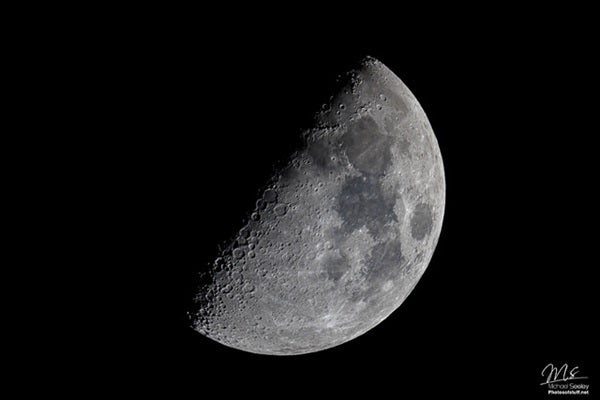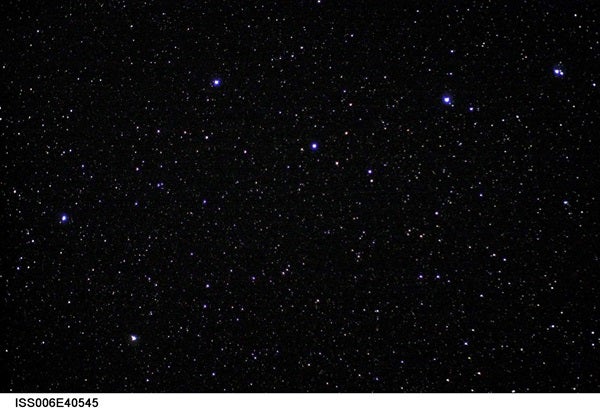Although Thanksgiving weekend signifies autumn to many people, the stars of both summer and winter appear prominent in late November’s evening sky. If you head out around 9 p.m. local time and look toward the west, you’ll see the bright stars of the Summer Triangle. These three luminaries — Vega, Deneb, and Altair — stand out nicely. Deneb appears highest (nearly halfway to the zenith), while the brightest, Vega, lies farthest to the right. Now, if you turn around and face east, you’ll find stars normally associated with winter. Betelgeuse, Rigel, Aldebaran, and Capella all clear the horizon before 8 p.m. and appear conspicuous an hour later.
Saturday, November 25
While the stars of summer and winter remain on view these late November evenings, the stars of spring are not so lucky. The Big Dipper swings low in the north at this time of year. Although this conspicuous asterism never sets from much of the United States and Canada, it does come close. And the star at the end of the handle — magnitude 1.9 Eta (η) Ursae Majoris — does dip below the horizon around 9 p.m. local time for viewers south of 40° north latitude.
First Quarter Moon occurs at 12:03 p.m. EST. As darkness descends across the Northern Hemisphere this evening, observers will find the half-lit Moon due south and nearly halfway from the horizon to the zenith. Our satellite spends the night in the constellation Aquarius the Water-bearer.
Monday, November 27
Mars stands out in the eastern sky before dawn this week. The magnitude 1.7 Red Planet rises more than three hours before the Sun and appears 20° high as twilight starts to paint the sky. It resides among the background stars of Virgo, and this morning it passes 3° due north (upper left) of the Maiden’s brightest star, 1st-magnitude Spica. (Mars remains within 3° of Spica through the morning of December 2.) Notice the stark color contrast between the orange-red planet and the blue-white star. Unfortunately, the view through a telescope proves disappointing — Mars spans just 4″ and shows no detail.
Tuesday, November 28
After the Sun sets this evening, look low in the southwest for Mercury. For observers at 35° north latitude, the innermost planet lies 7° above the horizon 30 minutes after sundown. Binoculars will help you to find the magnitude –0.2 object in the twilight glow. Binoculars will also reveal the fainter glow of magnitude 0.5 Saturn just 3° to Mercury’s upper right.
Wednesday, November 29
The second-brightest asteroid of 2017 puts on a nice show during November. Minor planet 7 Iris rides high in the evening sky among the background stars of Aries the Ram. It glows at magnitude 7.7 and should be relatively easy to spot through binoculars even from the suburbs. This evening, you can locate Iris 0.5° due east of the magnitude 5.9 star 4 Arietis.
Thursday, November 30
The variable star Algol in Perseus reaches minimum brightness at 9:27 p.m. EST, when it shines at magnitude 3.4. If you start watching it after darkness falls this evening, you can see it more than triple in brightness, to magnitude 2.1, over the course of a few hours. This eclipsing binary star runs through a cycle from minimum to maximum and back every 2.87 days. Algol appears high in the northeastern sky after sunset and passes nearly overhead around 10:30 p.m. local time.
Algol can guide you to one of the finest binocular star clusters in the late autumn sky. Just after darkness falls, target the variable star through binoculars and place it at the bottom of your field of view. At the top of the field, you should see a hazy patch of light roughly the size of the Full Moon. This is M34, a collection of roughly 100 suns near Perseus’ border with Andromeda. Through 10×50 binoculars, M34’s brightest stars appear to twinkle against the unresolved glow of the cluster’s fainter members.
Uranus reached opposition more than a month ago, but it remains a tempting target. The outer planet appears in the southeast after darkness falls and climbs highest in the south around 9 p.m. local time. The magnitude 5.7 world lies in southeastern Pisces 3.2° west of the 4th-magnitude star Omicron (ο) Piscium. Although Uranus shines brightly enough to glimpse with the naked eye under a dark sky, binoculars make the task much easier. A telescope reveals the planet’s blue-green disk, which spans 3.7″.
Saturday, December 2
Head outside before dawn and you’ll find Jupiter blazing low in the southeast. The giant planet rises 2.5 hours before the Sun and climbs 15° high an hour before sunup. Jupiter shines at magnitude –1.7, which makes it the brightest point of light in the night sky, and resides among the much dimmer stars of the constellation Libra. A telescope reveals the planet’s 31″-diameter disk.
Sunday, December 3
Full Moon officially arrives at 10:47 a.m. EST, though it will look completely illuminated all night among the background stars of Taurus the Bull. The Full Moon rises close to sunset, appears highest in the south around midnight local time, and sets as the Sun comes up. Our satellite reaches its Full phase just 17 hours before its closest approach to Earth during its monthly orbit. The coincidence between these two events makes this the largest Full Moon of 2017, and you can expect to hear the phrase “Super Moon” used to describe it. Just how special is it? This Full Moon spans 33.4′, 7 percent larger than average. Most people won’t notice that small of a difference, but you can bet a lot of them will head out this evening, see the bright Moon hanging low above the horizon, and be amazed at its size. But this is an illusion — viewing the Moon near familiar foreground objects tricks the mind into thinking it looks bigger.












